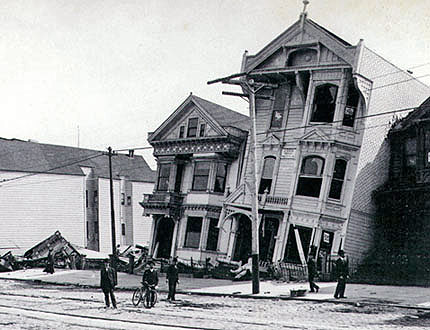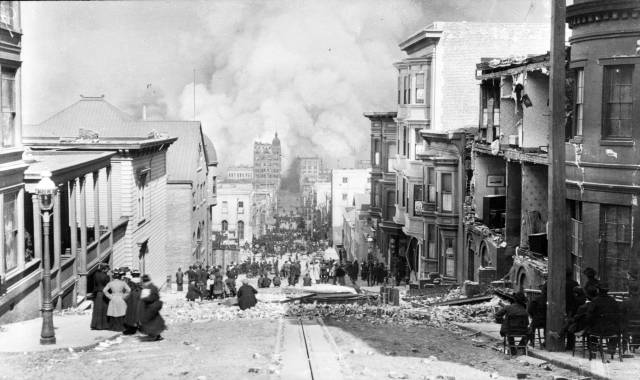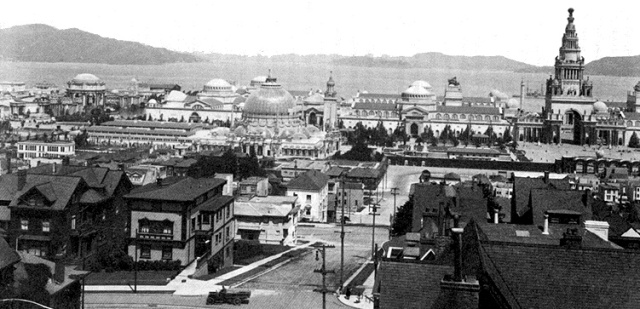The fires burned relentlessly onward. Shop owners, residents and city officials watched helplessly as the conflagration consumed block after block of their beloved city. The water pipes had been severed in so many placed that no water was available to fight the fires. The fire-fighting best plan utilized dynamite set by Army Soldiers to rubblize buildings in the way to create a ring of containment. This post-apocalyptic nightmare scenario was played out in truth 110 years ago in San Francisco.

The disaster had begun abruptly in the wee morning hours of April 18, 1906 when the highly strained rocks between the North American Plate and the Pacific Plate suddenly fractured and slipped. In all 275 miles of the San Andreas Fault gave way in a 45 second long event center 2 miles offshore of Mussel Rock in San Francisco. The event was a massive release of energy – an estimated 7.8 Moment Magnitude Earthquake that send intense seismic waves into the San Francisco Bay Area.

In the city, pandemonium reigned. Buildings collapsed. Houses teetered over. Water and gas lines burst. Masonry structures and facades proved especially vulnerable, crashing to the earth and killing many outright. Others were trapped beneath rubble, hoping for rescue before they perished. Numerous aftershocks were recorded, rending apart the weakened structures with renewed vigor. The ground liquefied in places, cobblestone streets were torn apart,and landslides occurred. Still, literally and emotionally shaken, San Francisco as the citizens knew it still remained.
Until the fires.
The flames began in dozens of locations from overturned cooking fires and ruptured gas lines. Like any city of the era, San Francisco had known fires of grand proportion. Yet here the menace could not be checked – the water lines that would normally permit them to fight the fires were likewise ruptures and useless. The city was already in disarray with blocked streets, thousands needing help in all directions. The small fires began to rage into massive infernos, consuming all in their path and combining steadily to become a mass fire. The fires did ten-fold more damage than the quake itself.

The flames respected no one. The tenements South of Market burned, but so did the mansions of Nob Hill. All of Chinatown was incinerated, as were the businesses of Market Street. The Palace Hotel, City Hall and numerous factories were all consumed. In all 80 percent of the homes then present were consumed – 25,000 homes in 490 city blocks. Only torched rubble remained four days later.

A few structures survived by happenstance and providence. Employees aided by soldiers saved the US Mint, owing to its sandstone exterior and water well in its interior. In its vaults lay 1/3 of the nation’s gold reserves. The Ferry Building remained, with firefighting tugboats drawing water from the adjacent bay. As a result, tens of thousands were evacuated in front of the wall of fire. Others were just beyond the fire lines.
An estimated 3000 people perished in the disastrous quake and fire. An accurate count is impossible, as the fire destroyed all evidence of any of the deaths, the records of City Hall were consumed to provide any estimate, and those who rebuilt deliberately underestimated the loss of life in official documents to encourage investors to provide needed reconstruction capital. Nor were the deaths limited to San Francisco proper, other cities, such as Santa Rosa, were likewise devastated.
The economic damage was massive. The hundreds of millions of dollars in losses (An estimated $10.5 Billion dollar price tag in 2015 Dollars) seemed insurmountable. Several insurance companies went bankrupt or only provided reduced compensation for claims. Others were faithful to their policies, even though it cost millions. Humanitarian relief poured in from across the nation and the world as well.
While the earthquake destroyed the old, the quake also meant a new beginning for San Francisco. Immediately following the quake, some thought of recreating the city in grand style with huge parks and avenues. While most of the dreams were not realized, the rebuilt city did provide numerous improvements with distinctive architecture and planning that marked a change from the ramshackle assortment of structures from the gold rush era onward. Additionally, areas such as Pacific Heights blossomed as some wealthier residents chose rebuild on fresh ground rather than clear away the debris from their old homes. Adjacent cities, such as Oakland, also saw an influx of displaced refugees who sometimes became permanent residents.
The shock and fear in the immediate wake of the earthquake gave way quickly to a resolute spirit to rebuild. Amadeo Giannini of the Bank of Italy, which later became Bank of America, began loaning money immediately after the dust settled. Giannini had the foresight to covertly transport his bank’s deposits outside of the City after the first tremors, meaning he had funds to lend right away at the temporary branch he opened to encourage rebuilding. Others followed suit and soon a city full of construction projects began to emerge. Galvanized into action, San Francisco arose rapidly from the devastation. So incredible was the recovery, a vibrant new San Francisco hosted the World’s Fair to celebrate its majestic rebirth just 9 years later.

The San Francisco earthquake also became the foundation for modern seismology. Professor Andrew Lawson thoroughly documented the characteristics of the quake with a team of assistants. The Lawson Report identified the San Andreas Fault as the cause, mapped its full extent, postulated the elastic rebound theory to explain earthquakes and discovered a direct correlation between the underlying geologic conditions and the magnitude of structural damage. These jump-started the science of seismology, and still contribute to our understanding of earthquakes today.
The Great San Francisco Earthquake caused America to view California as “earthquake country.” Indeed, with the San Andreas Fault and its branches, earthquakes in California are commonplace. However, the 1906 earthquake was not the largest in the United States. The 1964 Earthquake in Alaska was far more massive, as was the 1811 New Madrid Quake in Missouri. Yet, California’s seismic reputation is cemented in place, probably permanently. So Californians prepare for the next time – when the stored strain energy on the plate boundaries breaks loose with another massive tremor. The next “Big One” could be anytime.
